As creatures of habit, humans tend to gravitate towards familiar and preferred choices, sticking with what they know and trust.
Research conducted by Lucidpress reveals that companies with consistent messaging and branding enjoy a significant boost in revenue, ranging from 10 to 20 percent higher compared to those lacking consistency.
However, achieving consistency can pose a challenge. Maintaining uniform branding and tone across a single multi-channel campaign is already daunting, let alone extending it to multiple campaigns, platforms, product lines, and diverse audiences, both now and in the future.
The real question arises: How does one determine the most suitable branding strategy in the first place?
This is where brand archetypes play a crucial role.
What is Brand Archetypes?
Brand archetypes serve as symbolic representations of a brand’s identity, encapsulating its essence, values, and personality traits. By assigning human-like characteristics to brands, they become more relatable and memorable to consumers.
Initially conceptualized by Carl Jung, a renowned Swiss psychologist and psychiatrist, brand archetypes gained widespread recognition through publications such as “Archetypes in Branding” by Margaret Hartwell and Joshua C. Chen, and “The Hero and the Outlaw” by Margaret Mark and Carol S. Pearson.
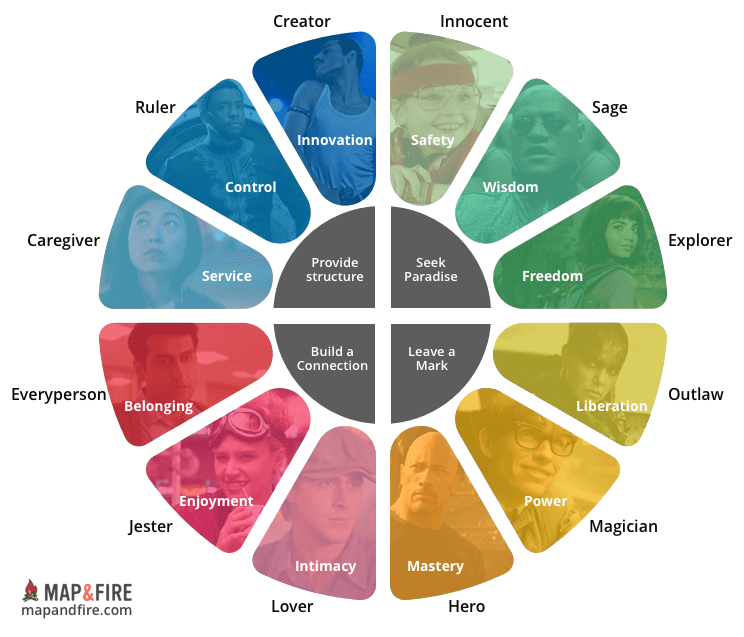
These archetypes are categorized into 12 distinct types, each embodying unique characteristics and appealing to different consumer preferences:
- The Innocent: Represents purity, goodness, and optimism, viewing the world with childlike wonder.
- The Sage: Stands for wisdom, knowledge, and guidance, acting as a trusted mentor or adviser.
- The Explorer: Embodies curiosity, adventure, and courage, seeking new experiences and discoveries.
- The Outlaw: Challenges norms and conventions, advocating for freedom and individuality.
- The Magician: Inspires awe and wonder through transformation and innovation, making dreams a reality.
- The Hero: Overcomes adversity and champions noble causes, demonstrating courage and resilience.
- The Lover: Creates intimate connections and meaningful relationships, evoking sensuality and passion.
- The Jester: Brings joy and laughter through humor and irreverence, defying seriousness and conformity.
- The Everyperson: Relatable and down-to-earth, embodies authenticity, hard work, and reliability.
- The Caregiver: Nurtures and protects, showing compassion and altruism towards others.
- The Ruler: Exudes authority and control, maintaining order and stability through responsibility and leadership.
- The Creator: Manifests imagination and innovation, building visionary products with enduring significance.
Learn about buyer persona here.
Real Life Cases with Respective Brand Archetype:
1. The Innocent: Coca-Cola
Coca-Cola epitomizes the Innocent brand archetype, crafting marketing campaigns that celebrate the simplicity and beauty of everyday moments. Their messaging revolves around cherished experiences like spending time with loved ones and embracing seasonal festivities, often portrayed through the lens of childlike wonder and imagination.
A prime example of Coca-Cola’s Innocent archetype in action is their iconic Christmas campaign, “Holidays Are Coming,” which evokes feelings of warmth and nostalgia.
Benefits:
- Coca-Cola’s Innocent branding evokes feelings of nostalgia, joy, and positivity, resonating deeply with consumers.
- Brands embodying the Innocent archetype are often perceived as trustworthy and genuine, fostering strong connections with their audience.
Drawbacks:
- While the Innocent archetype can be endearing, there’s a risk of over-saturation or appearing overly saccharine. If not balanced with authenticity and relevance, it may come across as insincere or disconnected from reality.
2. The Sage: TED Conference

TED, short for “Technology, Entertainment, Design,” embodies the Sage brand archetype by serving as a platform for disseminating ideas from leading intellectuals and innovators worldwide. Covering a vast array of topics ranging from climate change to modern dating, TED Talks offer insightful perspectives on virtually every subject imaginable.
One of TED’s key strengths lies in its role as a facilitator of discussions rather than dictating a singular viewpoint. This approach fosters an atmosphere of transparency and trust, positioning TED as a reliable source of advice and knowledge—an ideal characteristic for the Sage archetype.
Benefits:
- TED exudes intelligence and eloquence, presenting diverse viewpoints without imposing a specific agenda. This flexibility allows the brand to adapt to evolving societal norms and remain relevant over time.
- By prioritizing evidence-based insights and embracing change, TED maintains its status as a thought leader at the forefront of intellectual discourse.
Drawbacks:
- While wisdom is valued, excessive arrogance or dogmatism can alienate audiences. Striking a balance between expertise and approachability is crucial to avoid appearing condescending or detached.
3. The Explorer: REI
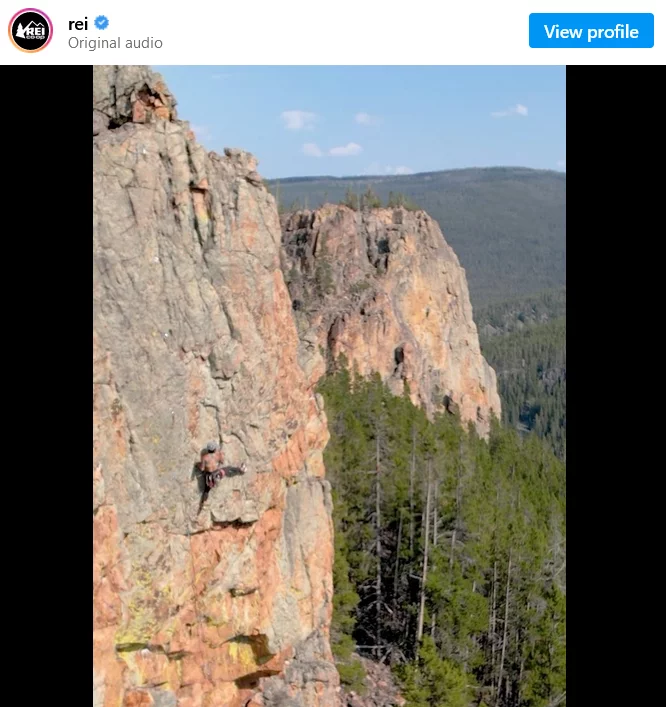
As a leading provider of outdoor gear, REI epitomizes the Explorer archetype with its emphasis on adventure and discovery.
For a company specializing in hiking boots and camping gear, showcasing the allure of nature and the thrill of exploration is paramount. Demonstrating a genuine passion for outdoor exploration helps REI connect with customers on a deeper level, aligning with their values and aspirations.
Benefits:
- The Explorer archetype embodies innovation and a relentless pursuit of new experiences. By continually seeking out fresh opportunities and challenges, REI inspires a sense of excitement and loyalty among its customer base.
- Customers are drawn to REI because of its adventurous spirit and commitment to exploration, fostering a community of like-minded individuals eager to embark on new adventures together.
Drawbacks:
- While the spirit of exploration is enticing, brands must be cautious not to appear unreliable or inconsistent in their pursuits. Overemphasizing novelty without a sense of reliability may undermine trust and credibility among customers.
- There’s a risk of appearing superficial or insincere if the brand’s adventurous persona feels contrived or overly commercialized. Maintaining authenticity is key to avoiding this pitfall.
4. The Outlaw: Harley-Davidson
Harley-Davidson epitomizes the Outlaw archetype, representing rebellion and freedom on the open road. Its association with the rebel spirit is so ingrained that it’s difficult to envision a renegade without picturing them astride a Harley.
Despite trailing behind competitors like Honda and Yamaha in global market share, Harley-Davidson remains the most recognizable motorcycle brand worldwide, thanks to its unwavering brand presence.
Benefits:
- The Outlaw archetype captivates audiences with its free-spirited, rule-defying ethos. Harley-Davidson’s consistent portrayal of rebellion in its marketing campaigns, such as the “United We Will Ride” video with Jason Momoa, resonates deeply with consumers.
- The brand’s allure extends beyond motorcycles, evident in the success of projects like “Long Way Up,” where Ewan McGregor and Charley Boorman ride custom Harleys. This archetype’s seductive appeal makes Harley-Davidson an icon of individualism and adventure.
Drawbacks:
- While the Outlaw persona exudes charisma, it may not inspire trust in areas requiring reliability or conformity. Depending on the brand’s niche, adopting the Outlaw archetype could be inappropriate or alienating to certain audiences.
5. The Magician: Dyson
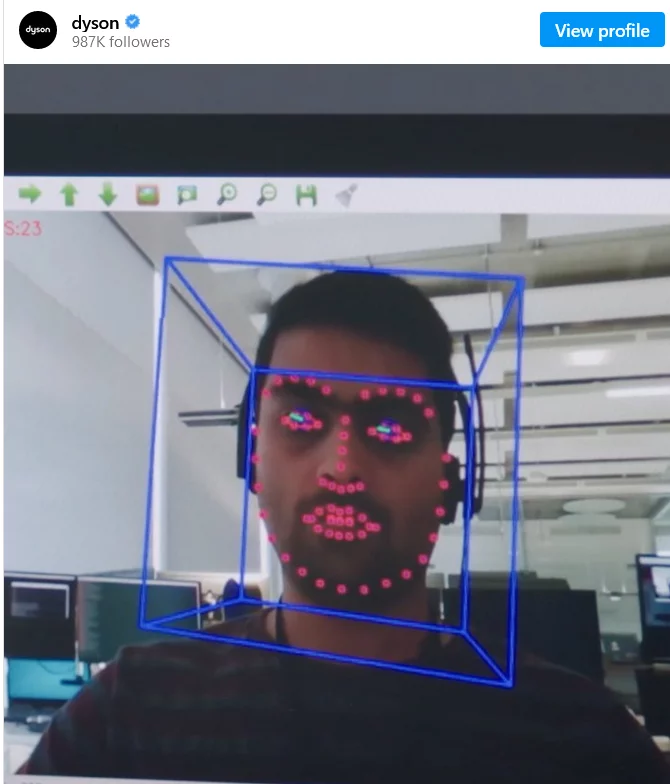
Dyson has masterfully transformed the mundane into the extraordinary, making vacuum cleaners not only functional but also desirable and worthy of investment.
By assuming the role of the Magician, Dyson has cultivated a reputation for groundbreaking innovation, presenting itself as a solution provider capable of enhancing our lives by reducing the drudgery of household chores like cleaning.
Expanding beyond vacuum cleaners, Dyson has applied the same enchanting approach to other product categories such as hair straighteners and air purifiers.
Benefits:
- The Magician archetype captivates audiences by consistently pushing the boundaries of innovation. Dyson’s commitment to groundbreaking technology ignites curiosity and excitement among consumers.
- By infusing charisma and energy into otherwise mundane products, Dyson engages consumers who may not have previously been interested in such items. The brand’s ability to captivate the majority of its audience speaks to the persuasive power of the Magician archetype.
Drawbacks:
- However, the Magician archetype, when misused, can evoke feelings of unease. In some cases, Dyson’s emphasis on innovation may appear distant or manipulative, potentially alienating certain consumers who prefer more straightforward messaging.
6. The Hero: Nike
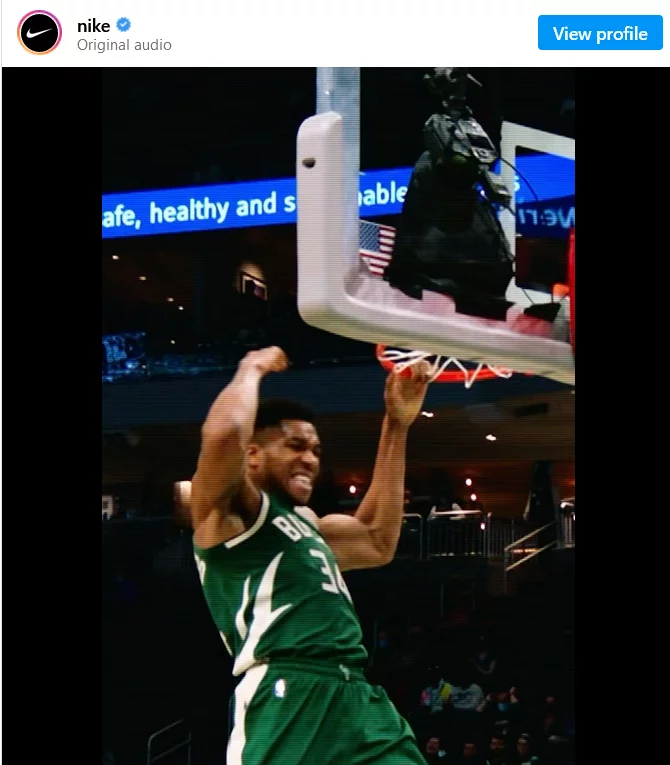
Nike epitomizes the Hero archetype, as its marketing narratives are replete with tales of individuals—from prominent ambassadors to ordinary consumers—persevering against formidable odds to achieve success.
It’s akin to envisioning John Cena’s persona in the world of athletic footwear instead of wrestling rings. This ethos is encapsulated in iconic slogans like “Just Do It” and “There Is No Finish Line.”
Benefits:
- By championing the narrative of overcoming challenges, the Hero archetype rallies universal support. Nike’s emphasis on resilience and triumph resonates with audiences, fostering a sense of admiration and allegiance towards the brand, despite its already dominant status in the sports apparel industry.
Drawbacks:
- However, a slight misalignment in messaging can swiftly transform the Hero into the antagonist, portraying the brand as conceited, confrontational, and overbearing. This delicate balance is exemplified by the polarizing reception of figures like John Cena in WWE and the preference of certain sneaker enthusiasts for Nike’s competitors, such as Adidas and Puma.
7. The Lover: Hallmark
Hallmark, the venerable greeting card brand, epitomizes the Lover archetype with its mission to foster emotional connections and enrich lives through meaningful relationships.
Benefits:
- Given the profound significance we attach to our closest relationships, messaging that celebrates and enhances these bonds naturally resonates with us. Hallmark’s emphasis on the value of intimate connections strikes a chord with consumers, appealing to their desire for love and affection.
Drawbacks:
- However, there’s a fine line between heartfelt sentiment and excessive sentimentality. While the Lover archetype can evoke genuine emotion, it runs the risk of appearing overly dramatic in certain contexts where a more restrained approach is preferred, such as in financial institutions.
8. The Jester: Old Spice
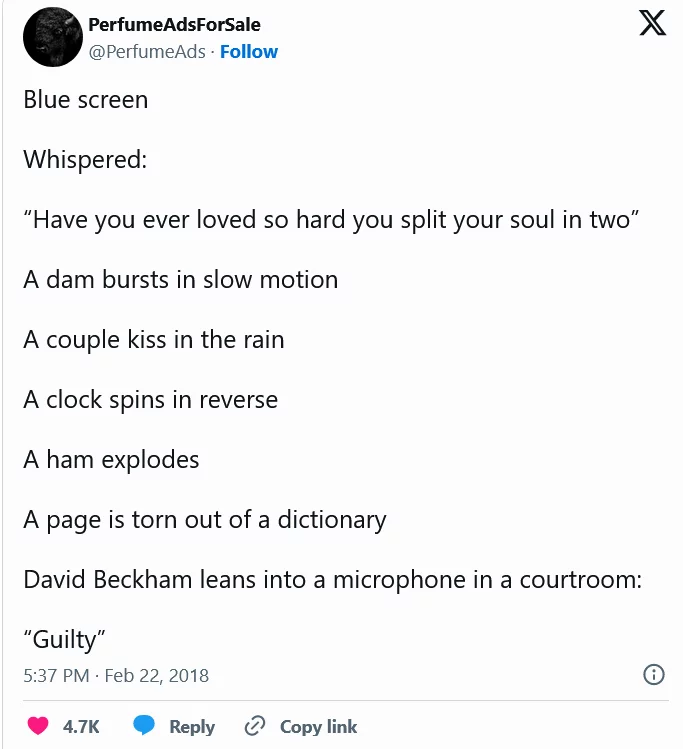
Old Spice, traditionally associated with mundane fragrance ads, made a bold departure by embracing humor and irreverence, effectively embodying the Jester archetype.
Benefits:
- When executed effectively, the Jester archetype yields highly shareable content that resonates with audiences. Old Spice’s comedic approach, epitomized by viral campaigns like “The Man Your Man Could Smell Like,” has garnered millions of views, showcasing the power of humor in brand marketing.
Drawbacks:
- However, humor is subjective and challenging to execute consistently. Additionally, a brand perceived as too comical may struggle to be taken seriously by consumers in certain contexts, potentially undermining its credibility.
9. The Everyperson: ASOS
ASOS excels at portraying itself as a relatable brand that resonates with the everyday consumer, despite being a multinational corporation.
Benefits:
- ASOS leverages relatable content, including memes, across its social media platforms to bridge the gap between the brand and its audience. By presenting itself as approachable and down-to-earth, ASOS fosters a sense of camaraderie with its customers, encouraging them to engage freely without fear of judgment.
Drawbacks:
- While cultivating a relatable image enhances accessibility, it may also detract from perceptions of innovation and uniqueness, particularly in industries where cutting-edge appeal is paramount.
10. The Caregiver: Volvo
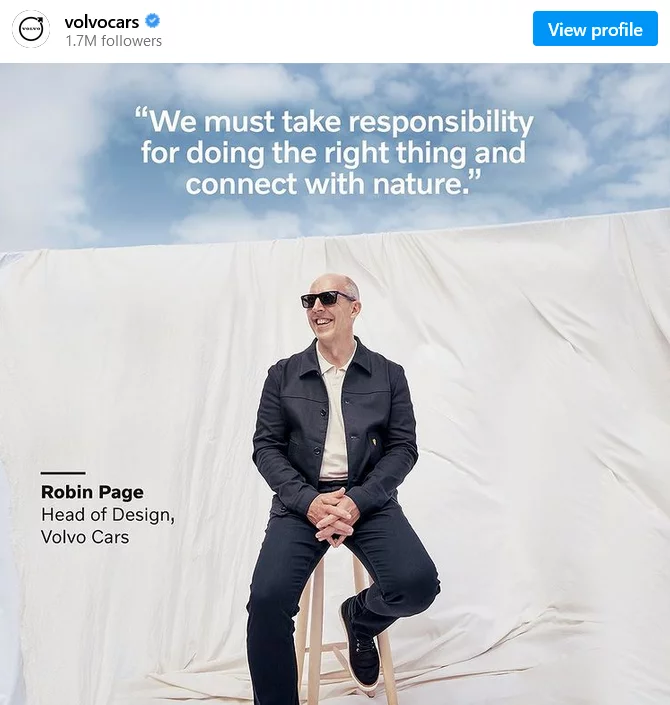
Volvo epitomizes the Caregiver archetype by prioritizing the well-being of its customers and the planet through safety-focused designs and sustainable practices.
Benefits:
- Volvo’s commitment to safety and sustainability resonates positively with consumers, eliciting goodwill and fostering trust. By aligning with values of social responsibility, Volvo cultivates a positive brand image that appeals to conscientious consumers.
Drawbacks:
- Despite its positive connotations, the Caregiver archetype may be perceived as less trendy or dynamic compared to other archetypes. Moreover, if a brand fails to uphold its stated values, it risks appearing disingenuous or manipulative.
11. The Ruler: Mercedes-Benz
Mercedes-Benz embodies the Ruler archetype, synonymous with excellence and German precision, as reflected in its enduring slogan, “The Best or Nothing.”
Benefits:
- Positioned as a leader in automotive engineering, Mercedes-Benz exudes trustworthiness and quality assurance. While not necessarily the most affordable option, it offers consumers a sense of security and assurance of top-tier craftsmanship.
Drawbacks:
- The Ruler archetype may struggle to evoke emotional warmth or connection with customers, potentially leading to perceptions of aloofness or detachment. If the brand fails to deliver on its promise of excellence, customers may quickly lose loyalty and seek alternatives.
12. The Creator: Adobe
Adobe epitomizes the Creator archetype with its suite of innovative and enduring products like InDesign, Photoshop, and Premier.
Benefits:
- As a Creator, Adobe inspires creativity and innovation, appealing to consumers who seek imaginative solutions. By providing tools that empower users to bring their ideas to life, Adobe fosters a sense of excitement and anticipation for what’s next in the creative realm.
Drawbacks:
- While creativity is celebrated, there’s a fine line between being innovative and appearing self-centered. Brands embracing the Creator archetype must ensure they maintain a balance between showcasing their creativity and remaining relatable to their audience.
Conclusion:
Understanding and leveraging brand archetypes can be a powerful tool for businesses to connect with their audience on a deeper level. By aligning their brand identity with archetypal characteristics that resonate with consumers, companies can craft compelling stories, foster emotional connections, and differentiate themselves in competitive markets. However, it’s essential for brands to authentically embody their chosen archetype and maintain consistency in their messaging and actions to build trust and loyalty over time.
FAQs on Brand Archetypes:
Is it possible for a brand to embody multiple archetypes simultaneously?
While it’s challenging to fully embody multiple archetypes, brands can exhibit traits from different archetypal categories based on the context of their communication and marketing strategies. However, maintaining coherence and consistency across various archetypal characteristics is crucial to avoid confusing or alienating consumers.
How can brands ensure authenticity when adopting a specific archetype?
Authenticity is essential for successful archetype adoption. Brands should align their actions, values, and messaging with the chosen archetype consistently across all touchpoints. Transparency, sincerity, and genuine commitment to embodying the archetype’s traits contribute to building trust and credibility with consumers.



